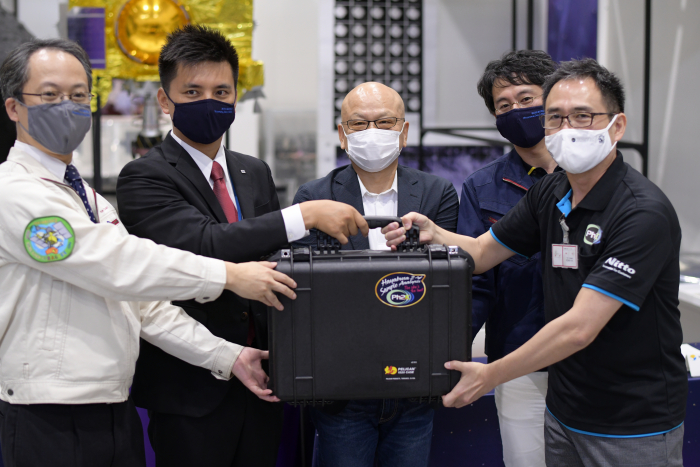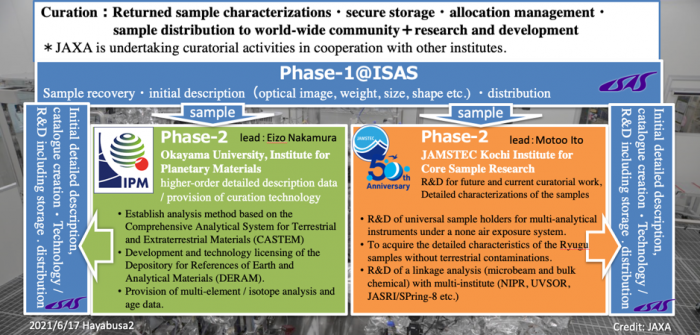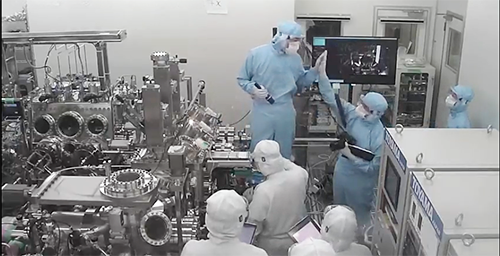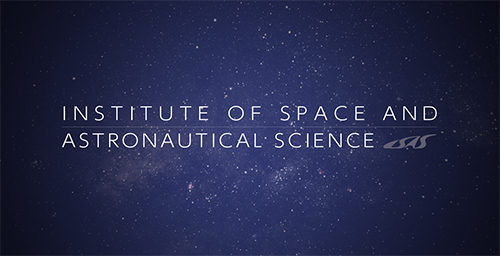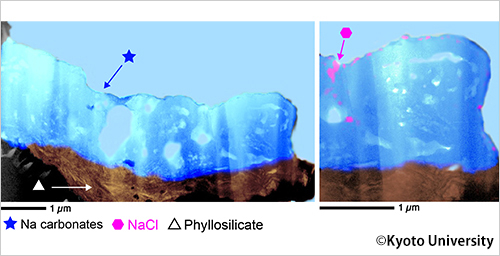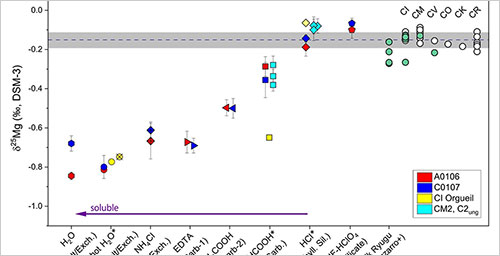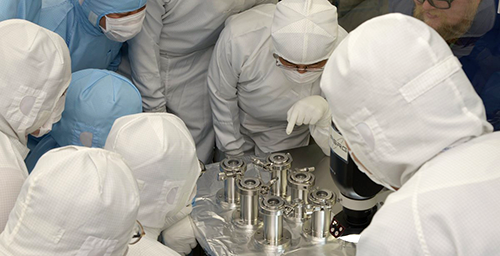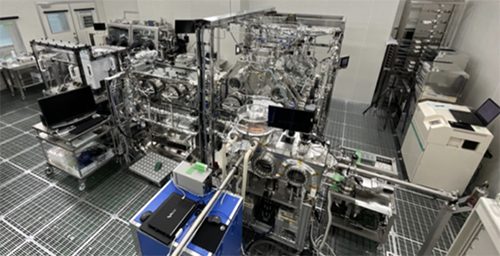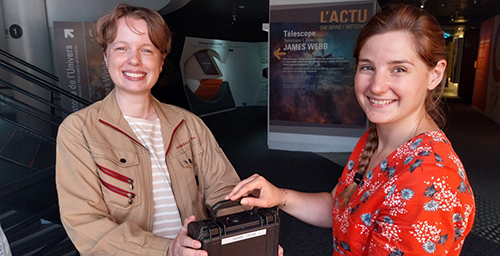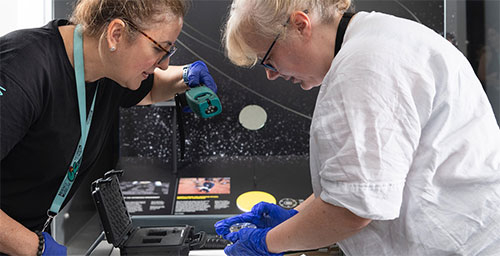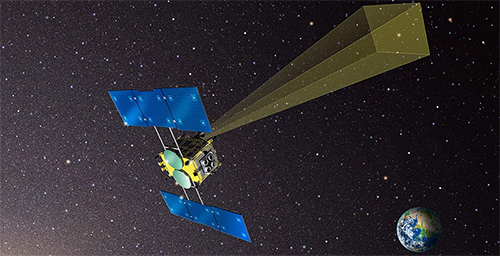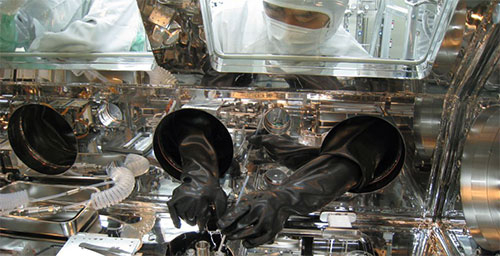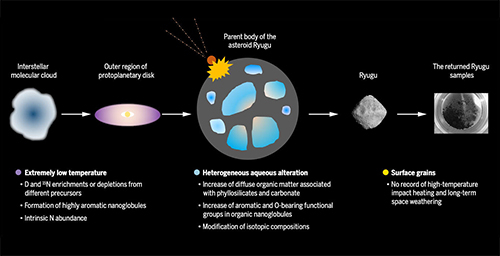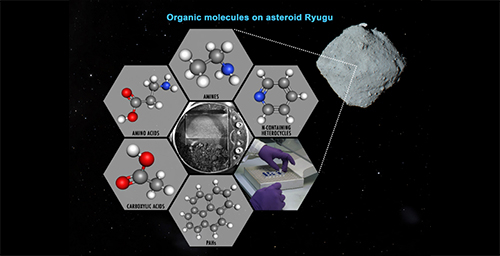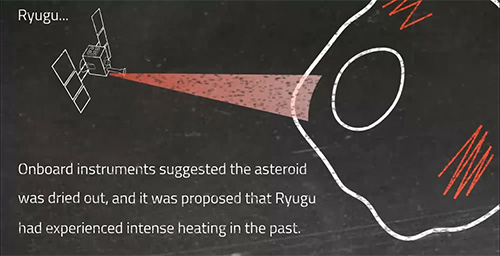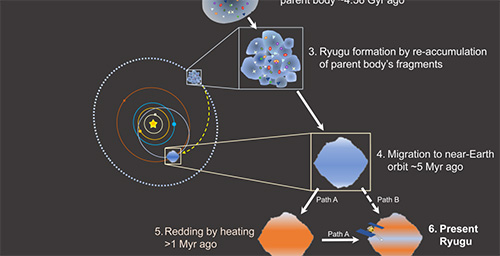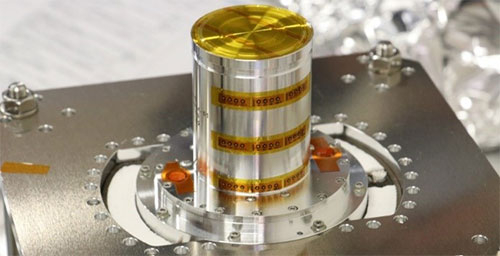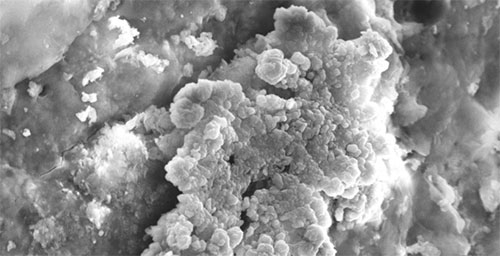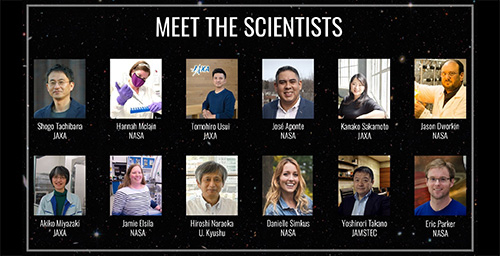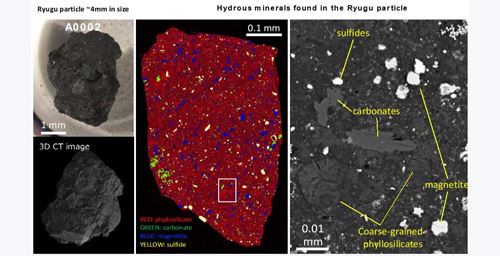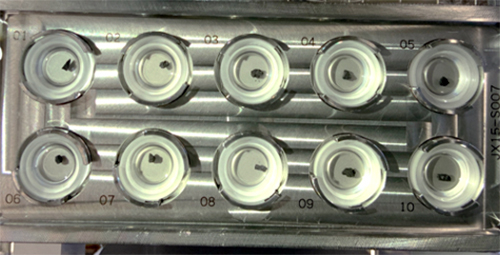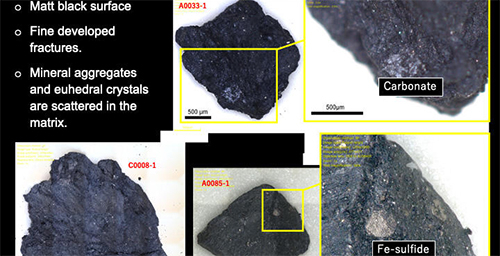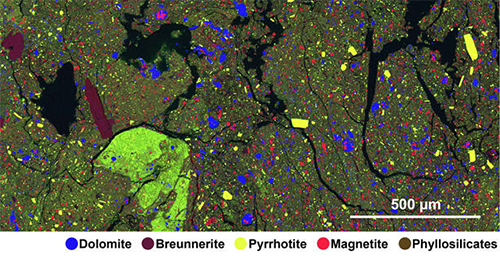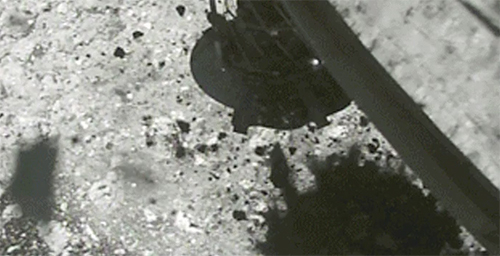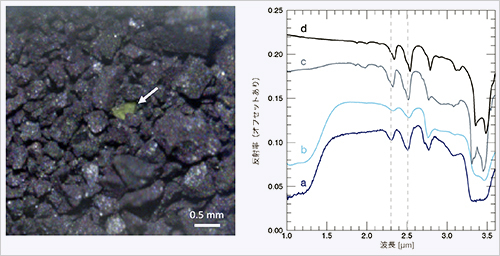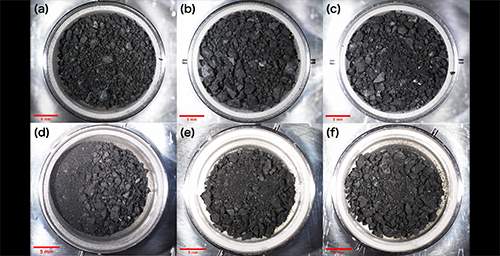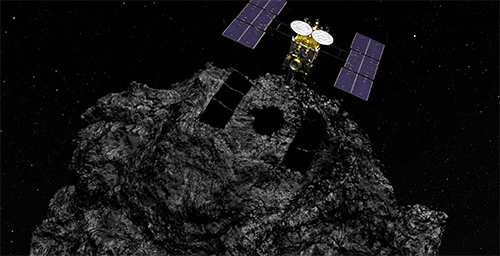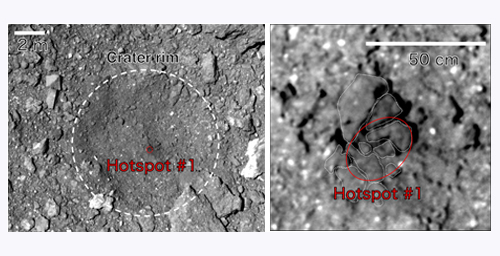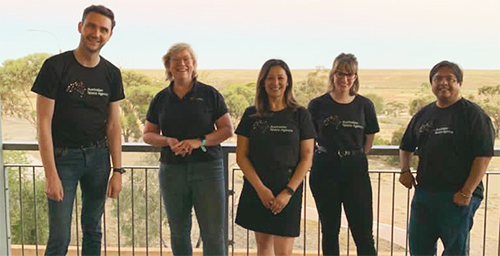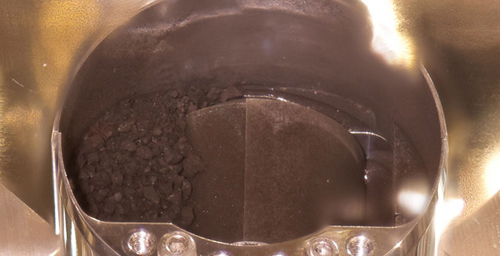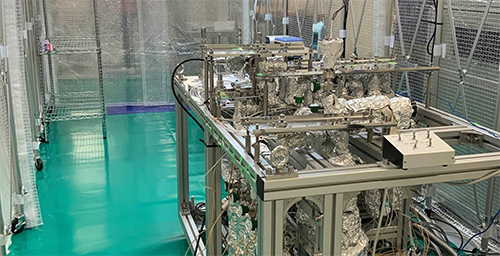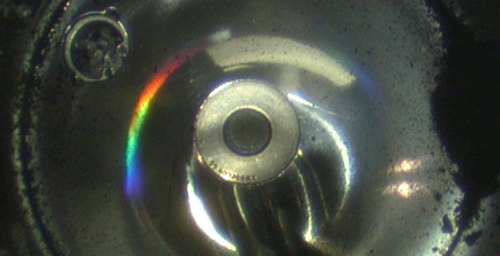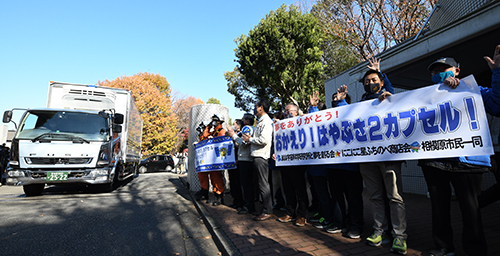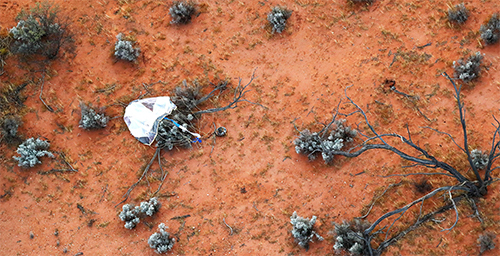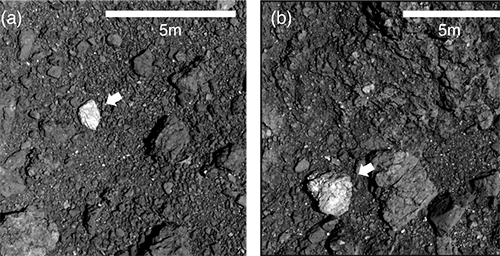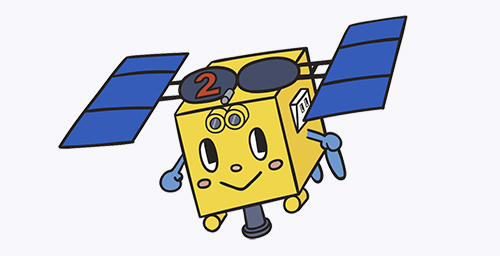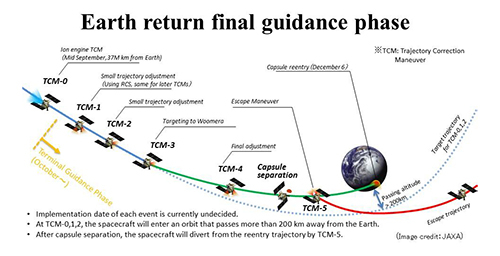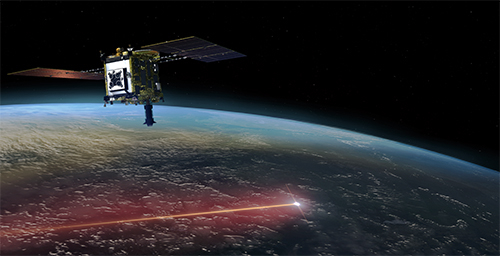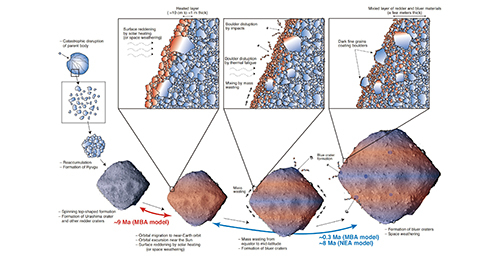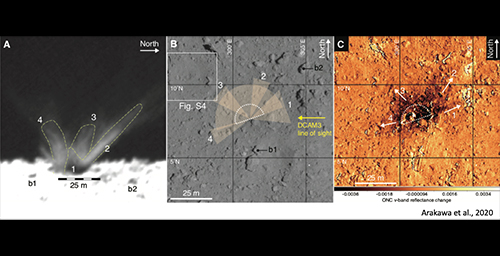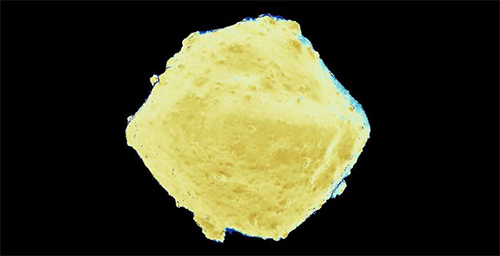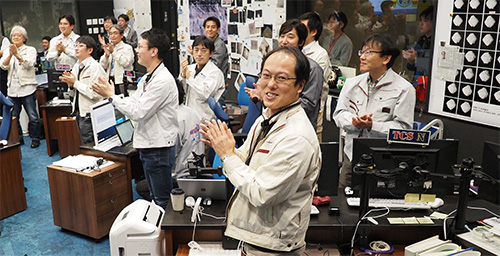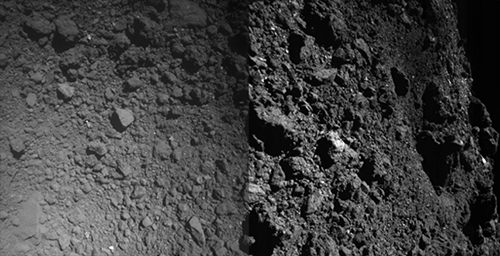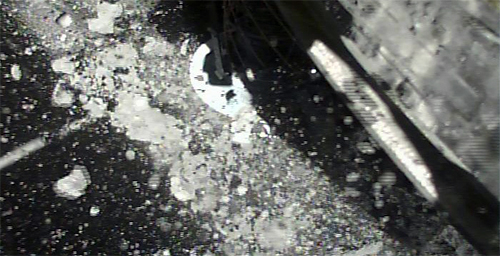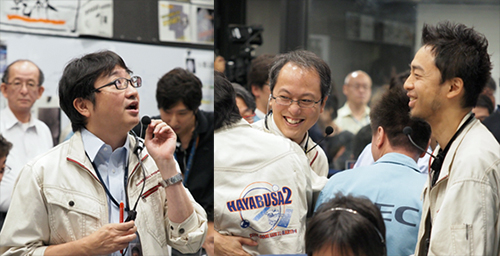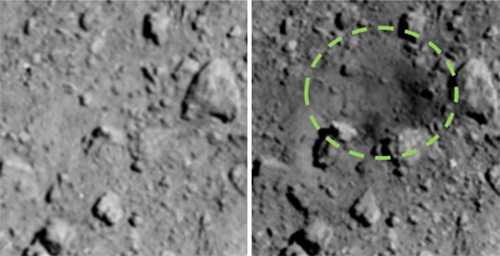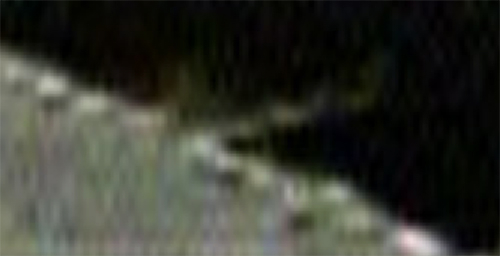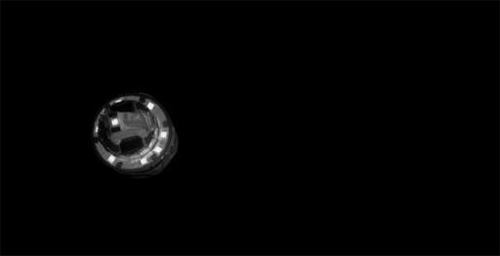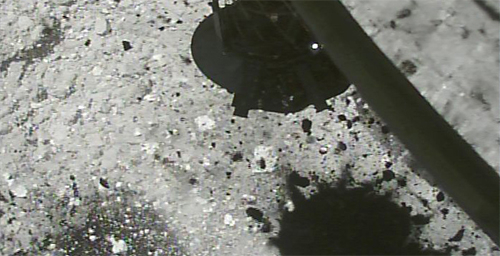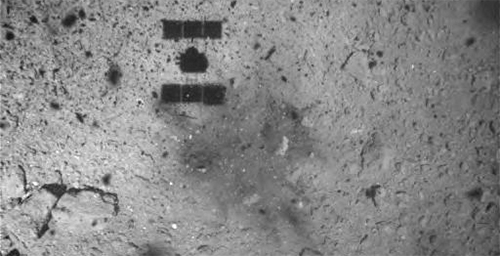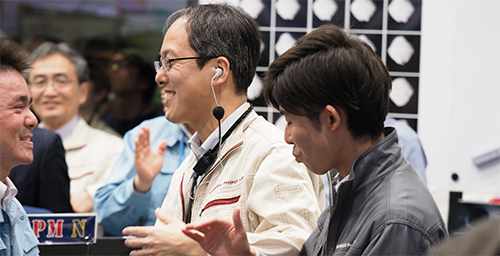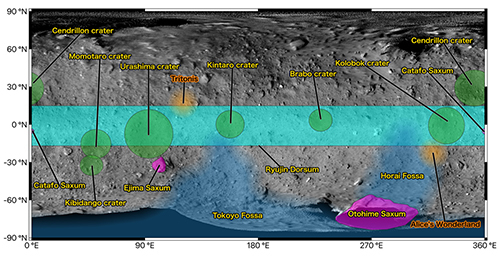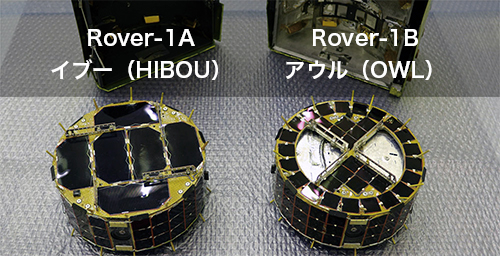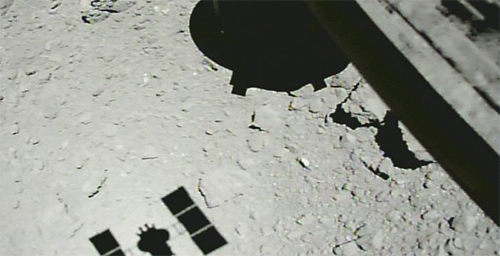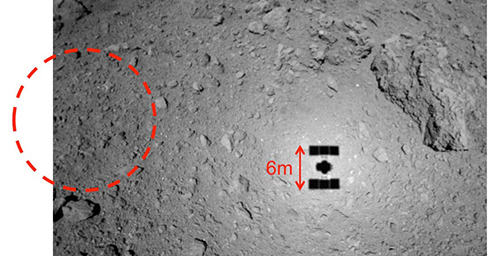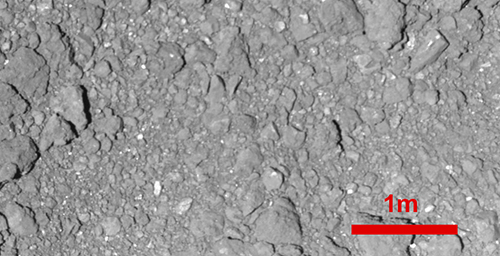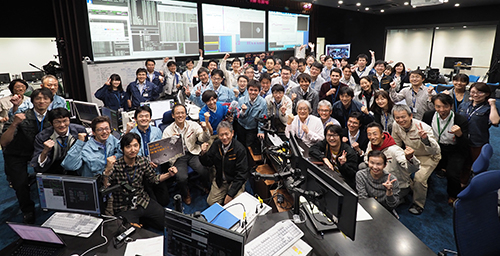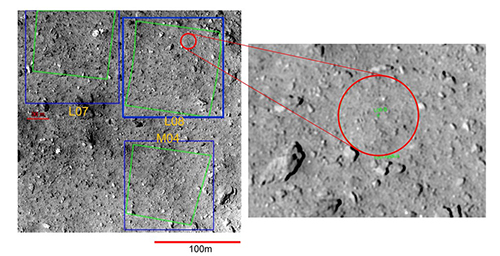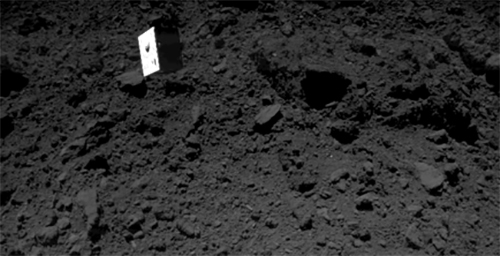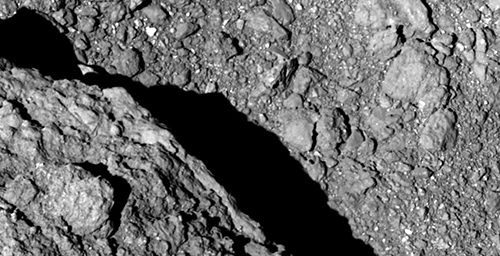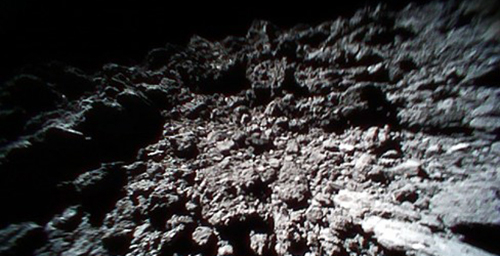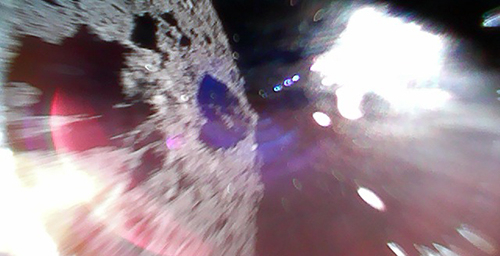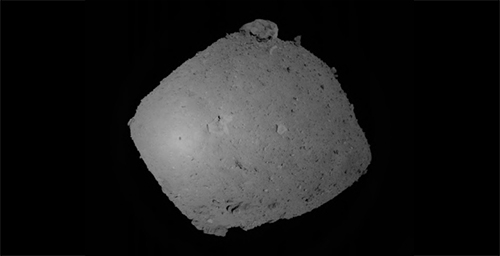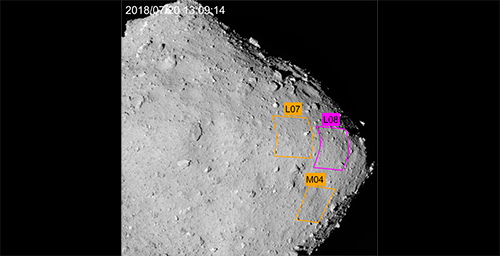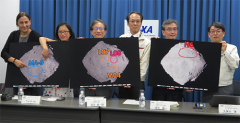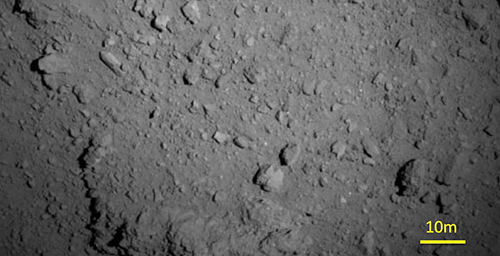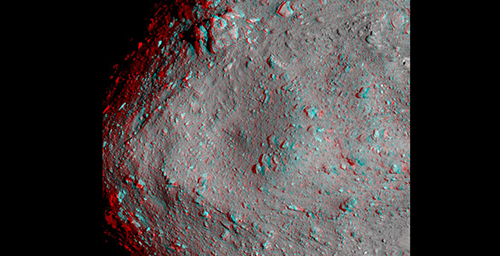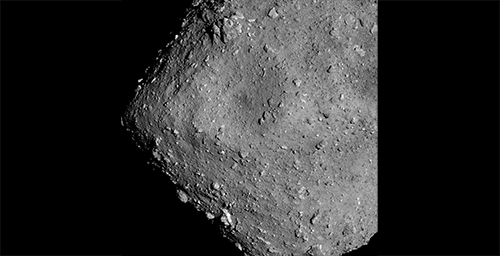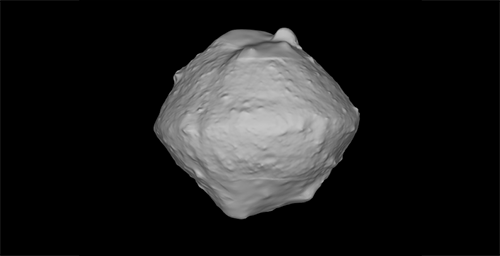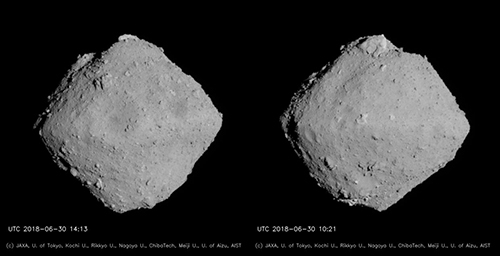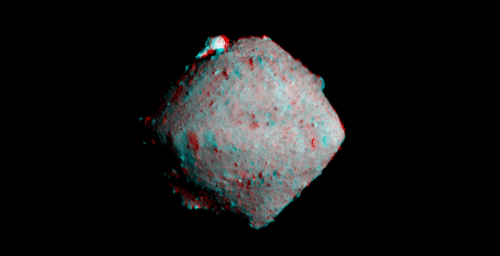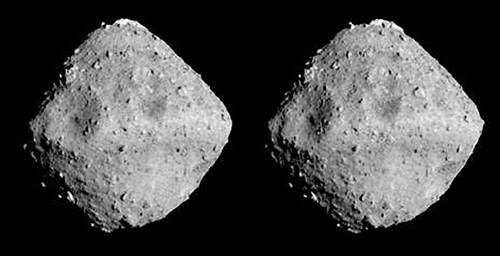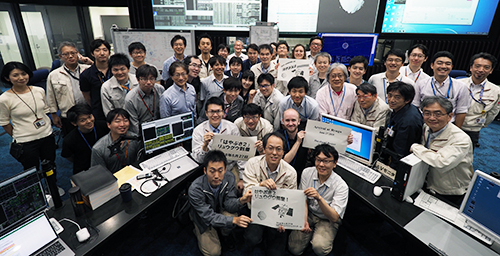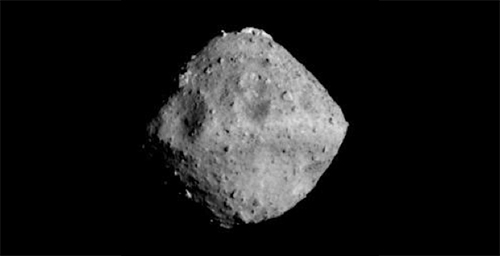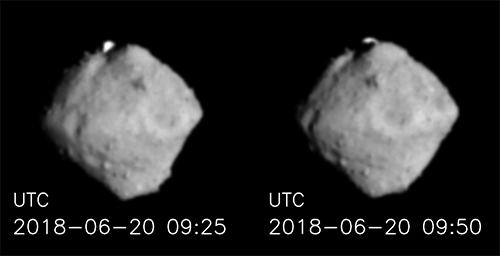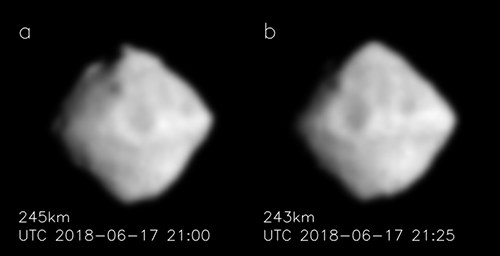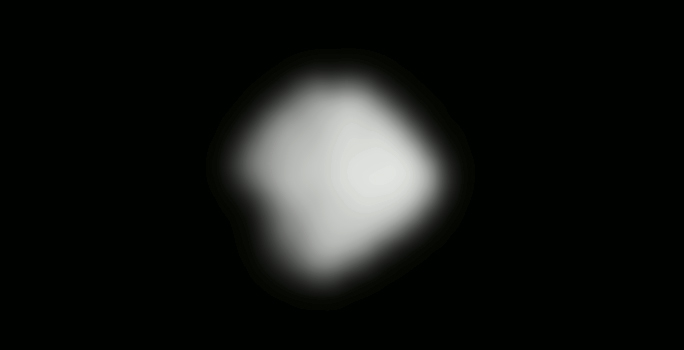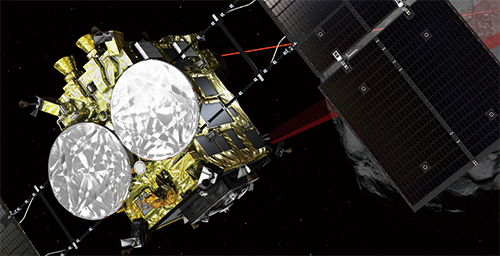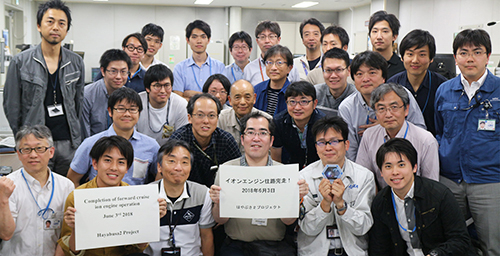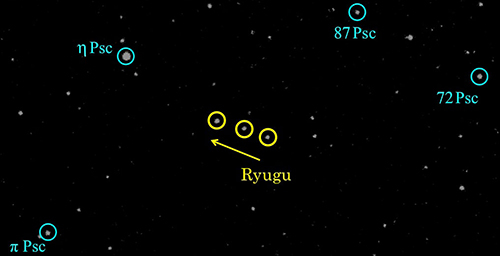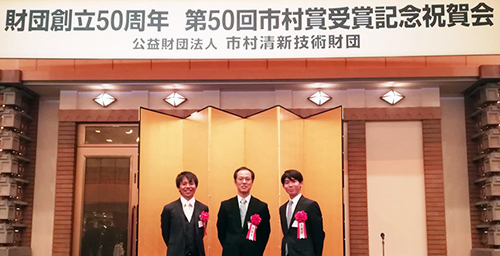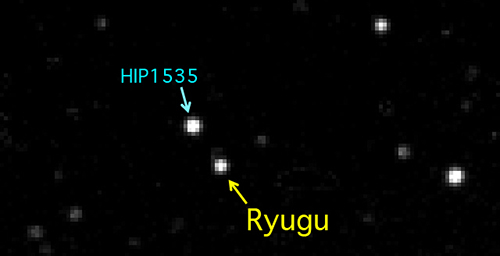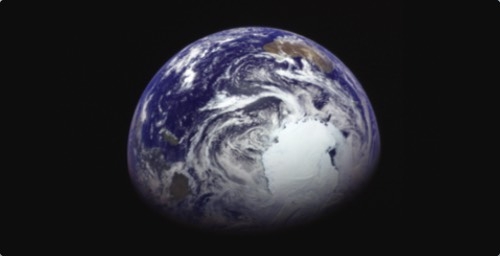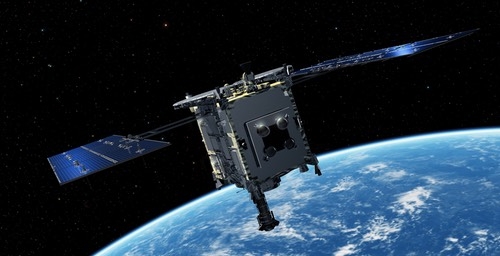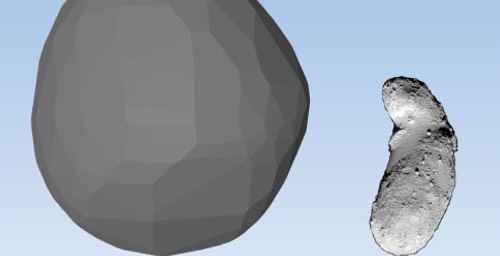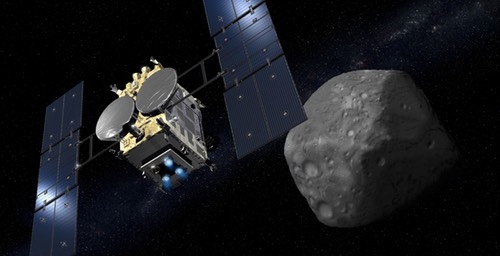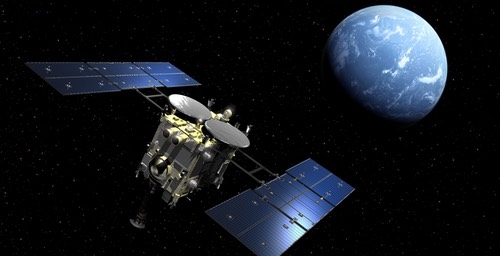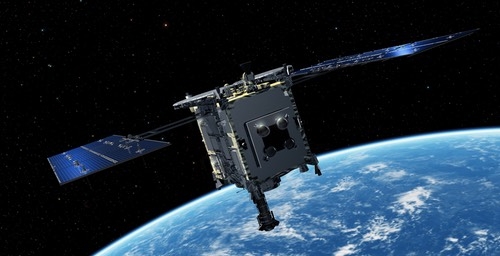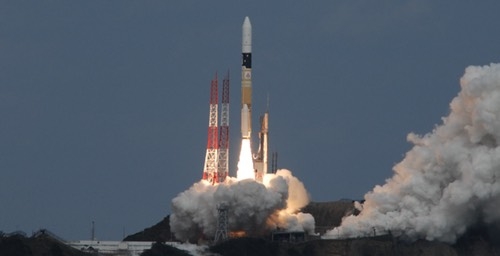Sample delivery ceremony on June 17. From left: JAXA Hayabusa2 Project Manager TSUDA Yuichi, JAXA Hayabusa2 Project Integrated Science Team Member USUI Tomohiro, Phase 2 Curation Misasa Team Leader NAKAMURA Eizo, Initial Analysis Team Manager TACHIBANA Shogo, Phase 2 Curation Kochi Team Leader ITO Motoo (credit JAXA).
1.Overview
The Phase 2 curation※1 Kochi Institute team, led by Principal Investigator ITO Motoo, from the Kochi Institute for Core Sample Research at JAMSTEC (Japan Agency for Marine-Earth Science and Technology), will begin analysis of the particles from asteroid Ryugu at the large synchrotron radiation facility, SPring-8※2, from June 20. This analysis is part of the SPring-8 long-term project, "Initial analysis of the Hayabusa2 samples using X-ray CT; technical developments, evaluation of analytical methods and analysis" (PI: Professor TSUCHIYAMA Akira at Ritsumeikan University).
2.Background
Between formation to the present day, our home on planet Earth has lost its early materials due to a variety of metamorphic processes and alternations brought about through heating. On the other hand, the destination of the Hayabusa2 explorer, asteroid Ryugu, is thought to have been less affected by sources of internal heat, so there is a possibility that the asteroid has preserved the organic matter and hydrous minerals originally acquired when the Solar System was forming 4.6 billion years ago. If we can obtain scientific information about the materials present in the earliest epochs of the Solar System, this should cast light on our 4.6 billion year history, from the formation of the Solar System, the origin of the water on Earth and evolutionary process for organic molecules that led to life on our planet.
The Japan Aerospace Exploration Agency (JAXA) has previous succeeded in a round-trip to asteroid Itokawa, with the asteroid explorer Hayabusa. The mission successfully acquired a small quantity of surface material from the asteroid. Hayabusa2 was developed from this success for the scientific exploration of the more primitive carbonaceous asteroid Ryugu.
Hayabusa2 was launched on December 3, 2014. The spacecraft arrived at asteroid Ryugu and performed close-range spectroscopic observations as well as succeeding in sampling twice from the surface of the asteroid and underground material. Then on December 6, 2020, the capsule containing the sample material returned to the Woomera Desert in Southern Australia. The collected sample capsule was confirmed to contain black sand-like particles with a total weight of about 5.4g.
At the JAXA Extraterrestrial Sample Curation Center (ESCuC), initial descriptions of the particles were conducted mainly using optical observation and weight measurements for individual particles. On June 17, JAXA distributed samples to two teams for Phase 2 curation and six teams for the initial analysis. The multi-institutional Phase 2 curation Kochi team led by JAMSTEC will work closely with the JAXA ESCuC to analyse the valuable sample from asteroid Ryugu.
3.Details of the Kochi Team analysis
Since 2015, the Phase 2 Curation Kochi Team has been working with the JAXA curation team to develop and provide technology for universal sample holders suitable for multi-analytical instruments, and sample transport containers that can be pumped to a vacuum or filled with an inert gas, for analysing the valuable samples obtained from sample return missions without compromising the sample. The development and advancement of analytical technologies and instruments through cross-disciplinary and multi-institutional collaboration has been strongly promoted since 2017. The Kochi team will be in charge of the analysis of the Hayabusa2 sample in collaboration with JAXA Curation, making full use of the analysis techniques and instruments that have been developed.
From June 20 - 23, non-destructive analysis of the three-dimensional shape, internal structure and mineral distribution of the Ryugu sample will be conducted at the large synchrotron radiation facility SPring-8 BL20XU. This analysis will use an "integrated CT environment" that combines multiple CT (computed tomography) methods using synchrotron radiation X-rays, such as X-ray diffraction CT※3 (XRD-CT) and phase-contrast CT※4, which were newly developed for analysing Ryugu samples that are thought to contain water and organic matter. In addition, the nanoCT analysis method is planned at the facility for the fall of this year to achieve high-resolution, three-dimensional visualisation of the distribution of organic matter in the Ryugu sample.
Based on the obtained 3D internal structure data, different research institutes will efficiently extracts the minerology and chemical information of the organic matter within the Ryugu sample. JAMSTEC Kochi Core Sample Research Institute will perform final mineral structure and ultra-high resolution isotope imaging analysis, the National Institute of Polar Research will tackle main element composition and mineral composition analysis, the Institute for Molecular Science at the Extreme Ultraviolet Light Research Facility will conduct the molecular structure analysis of organic matter, and a collaboration is planned with the Tokyo Metropolitan University for elemental composition analysis and so forth.
By integrated these analyses, different aspects of the space science can be addressed including the chemical evolution of organic matter on asteroid Ryugu, the location where rocks and minerals have co-existed with water and organic matter, the relationship with known primitive meteorites and the origin of the Earth's water.
(Glossary)
※1: Phase 2 curation
The JAXA ISAS Extraterrestrial Sample Curation Center (ESCuC) was established with the main purpose of accepting and managing samples of material from extraterrestrial bodies returned from sample return missions such as Hayabusa. For Hayabusa2, ESCuC and the collaborating institutes selected by the JAXA Curation Expert Committee (multiple research institutes centered on JAMSTEC Kochi Core Sample Research Institute and Okayama University Institute for Planetary Materials) are creating a cooperative system for Phase 2 curation. For Phase 2 curation, the Kochi team are working in collaboration with the ESCuC to develop sample distribution containers, transportation / transfer equipment and analytical techniques for curation activities in an atmospheric-free environment. The objective of the project is also to maximize the scientific results from asteroid Ryugu by improving the detailed material science description of the Hayabusa2 sample through the advanced analysis technology developed by each institution.
(Reference) Curation system diagram
※2: Large synchrotron radiation facility, SPring-8
RIKEN facility that delivers the world's most powerful synchrotron radiation currently available. The synchrotron is situated in Harima Science Park City, Hyodo Prefecture, while user support is provided by the Japan Synchrotron Radiation Research Institute. The name "SPring-8" is derived from "Super Photon ring-8 GeV". The SPring-8 electron acceleration energy (8GeV: 8 billion electron volts) can produce synchrotron radiation over a wide wavelength range from far infrared to visible light, vacuum ultraviolet, soft X-rays and hard X-rays. A shared facility for researchers from Japan and overseas, SPring-8 is used in a wide range of fields such as material science, Earth science, life science, environmental science and industrial use.
※3: X-ray diffraction CT (XRD-CT)
CT is an abbreviation for Computed Tomography, which is a method to numerically reconstruct 3D information from projected images of the subject taken from multiple directions. Conventional CT has difficulty in identifying multiple different minerals contained within a sample, so a limited mineral identification method that utilizes differences in the energy absorption characteristics of each element called DET (duel-energy tomography) was used in the analysis the Hayabusa sample. The Hayabusa2 sample analysis will be performed by a combination of X-ray diffraction (XRD) analysis and CT--the synchrotron radiation XRD-CT method. This method allows the identification of many mineral types and their spatial positions with high resolution although the constituent minerals in the sample are unknown. For example, this method facilitates precise distinction between the spatial positions of minerals in the samples that contain water and those that do not.
※4: Phase contrast CT
If the rocky material contains substances that absorb X-rays much more weakly compared to other minerals, such as organic matter, water or gases, the contrast is so weak that they cannot be distinguished. Phase-contrast CT is a method that can boost the contrast in CT images up to about 1,000 times of substances that have weak X-ray absorption. With this technique, it is possible to distinguish between water, organic matter and air in rocky materials and investigate their location within the sample.

